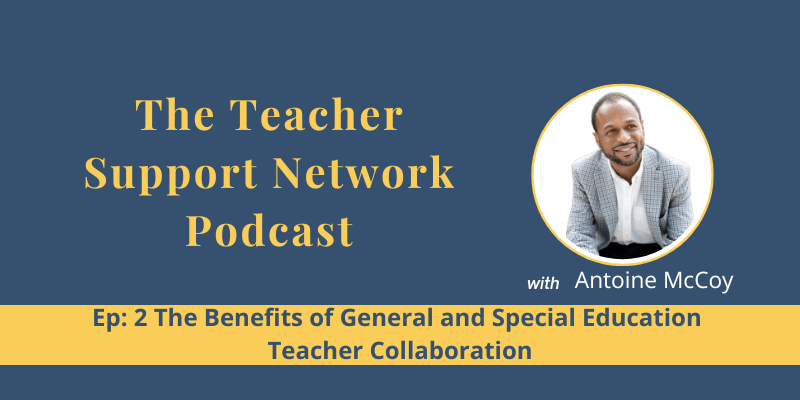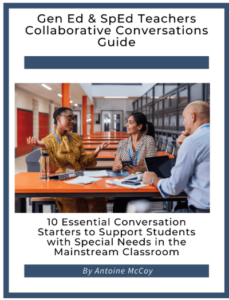
In this episode ~
We explore how collaboration between general and special education teachers can unlock powerful benefits for students with disabilities. Listen in to discover why working together creates stronger classrooms for everyone.
Listen in~
Transcript
Hey there. Welcome to the Teachers Support Network, your go to podcast for helping busy educators and teachers like yourself. Create more inclusive classrooms, foster effective teacher collaboration, and focus on your own well-being in the process. I’m your host, Antoine McCoy. In this episode, we will be diving into the benefits of effective teacher collaboration between Gen Ed and Sped teachers. So let’s get it started.
Creating inclusive environments for students with special needs in the mainstream classroom is really central to their academic and social growth, as you probably know. What really truly fosters and and enhances that growth is when General and SpEd teachers, along with other support staff, work together as a team. It’s that teamwork that really helps students thrive. Did you know that students with disabilities and inclusive classrooms tend to perform better academically and socially when teachers collaborate efficiently?
Because of that, we start talking about collaboration which I think is a huge topic that I think is important in terms of the education arena. We’re going to explore three benefits of teacher collaboration and its impact on students with disabilities in mainstream classrooms. So let’s look at the first benefit teacher collaboration.
Benefit number one is student outcomes are improved. I mean, it seems to make sense, but sometimes people don’t really understand the power of outcomes that students have when teachers collaborate together. When teachers collaborate, students with disabilities receive more specific and individual support while being exposed to and engaging in the same lessons as their non-disabled peers. And so this really targeted support leads to better academic and social success overall. When a GenEd teacher and a SpEd teacher work together to support a student with a disability in the in the classroom, you can differentiate instruction a lot better to reach a specific student or group of students at their current level or that specific level, while helping them to move forward to the next academic level.
What that might be, whether it’s towards the actual grade level standard or wherever to the next grade level standard, it’s that’s important for them to reach the next milestone. When I think about this, the student outcomes being improved, I’ve seen it happen in many different teaching settings. But the one that that really comes to mind for me is when, I was working in a high school a few years back, and the school in general, I had a school improvement grant. They were looking at the beginning of the year, the test scores for the year before and overall the school had improved. The students had improved in all these areas. But the one thing that I was looking at on that chart at the staff meeting, um, the students with disabilities, because that was the SpEd teacher.
I realized that while the general population of students had improved, that the students with disabilities had not really improved as much. And so that was a concern for me because I was there to help improve their student outcomes. I remember having a meeting with my administrator and we were talking about that a little bit. I remember he asked me a very specific question that I’ll never forget. And he asked, “So, Antoine, like, what do you need? What do we need to do to maybe change that to help our students do better overall. Not just words, but, you know, for the the state standard, you know, the state tests, but just in general?”
When I looked at how we had things set up at the school and things like that, I was able to see my students, maybe for a class period a day or every other day. But I didn’t get to see them all the time, based on the model we had at the time. And so I said, “I need to see my students, I need to be in the classroom with them so I can help them real time.”
He took that to heart. Because I was working in math and algebra one, we started with a junior teacher who was open to the inclusive process.
We had a lot of students with disabilities in that classroom. For that year, we worked together and I think I worked with maybe another teacher as well. It was a while ago. I was able to help my students in real time in the class while working with the GenEd teacher and also helping other students in the process.
When we looked at the scores a year later, our students had made significant growth in that area of math. I’m not saying it was all because of the collaboration that was happening, but I knew that a lot of it had to do with the fact that I could be there helping them real time, and that when you can work together real time with students, you can help intervene in a moment and really spot some of the problems that you would have. That I would not necessarily be able to see if I wasn’t in the classroom. And so that was a very significant time where I really realized the power of collaboration together and how that model works and things like that. We’ll talk about that more specifically in other episodes.
But just the power of, the benefit of that in terms of student outcomes, I really saw. Not only does it improve student outcomes, but the second benefit of teacher collaboration is that you can work together to have collective input on developing effective individual education plans, the IEP, It’s one thing when you as a teacher had to write them, I was responsible for the IEPs and goals and things like that. But when you’re able to work together with the GenEd teacher and other professionals involved in that and with the student, you can look at the GenEd in grade level standards as you write your goals so that they’re very practical, especially in the mainstream classroom. You can work collectively on that.
When it comes to accommodations and modifications, you can both have input on that. It’s so important because sometimes, you can have an accommodation on modification that might not be really practical in the unit setting itself, but when you work it together and you’re coming together to kind of look at those accommodations and modifications, they become more useful and practical within the Gen Ed setting, ultimately, benefiting the student, um, and their success. So I found that collective input on IEPs, particularly in goals, accommodations, etc., is really an important benefit of teacher collaboration.
The third benefit that we’ll look at, there are many more, but I’m just looking at three in this particular episode. It is shared expertise and professional growth for you as a teacher. When you collaborate together, teachers are learning from one another. You’re gaining new strategies and perspectives that really benefit all students. Junior teachers can acquire skills for how to differentiate instruction, SpEd teachers can deepen their subject matter, knowledge and ways to teach more whole groups of students.
So there’s a shared expertise that you’re bringing to the table that the other teacher or your colleagues get to benefit from, but at the same time, you get to benefit from them as well. And it just makes you a stronger educator, a stronger professional overall, which ultimately is going to help be a better teacher for your students. And so the shared expertise and professional growth of teachers is super important and a big benefit in terms of teacher collaboration. So as you can see, there are many benefits to GenEd and SpEd teacher collaboration that benefits students with disabilities and their non-disabled peers, as well as your professional growth as a teacher.
And so, you know, I always like to have teachers that I work with or people that I come in contact with to say let’s not just take this information, but how do we connect it to our practice? Because it’s the action in the reflection that really where the benefit comes in terms of changing practice and improving practice.
So here’s a couple of questions to to consider.
Of these three benefits discussed in this episode today, have you witnessed which of these three benefits. which ones have you seen in your practice?
Which one of these benefits do you need to explore more in your teaching practice? There are some things that benefit but it doesn’t necessarily mean that we’re taking advantage of it and our settings. So which of these do you think you need to explore more in your teaching practice and how might you explore that more in a very practical level where you’re at? That’s going to be different for everyone.
With that said, that’s it for today’s episode.
I have a free resource for you that I want to talk about really quick. In order to start fostering and spreading teacher collaboration or to take what you’re already doing to the next level, I have a free resource for you that has ten conversation starters to promote better collaboration between Gen Ed and Sped teachers. You can find the link to the show notes in the resource section of the show notes for this episode. So if you go to the show notes andResource section, you can click on the link and get your copy.
If you found this episode helpful and if you know someone who can benefit from the message, please share it with your fellow teacher so we can get the word out and we can get some of these short, practical, bite sized pieces of information and content out regarding collaboration and inclusive education working with students with disabilities to people you work with and people who may need it.
That’s it for now. Again, until next time, stay well and take care.
Resources
Get your complimentary copy of the Gen Ed & SpEd Teachers Collaborative Conversations Guide here.
Let's Get Social
Rate, Review, & Subscribe on Apple Podcasts
Enjoy this episode?
Please consider rating and reviewing the podcast! Your support helps me support more teachers - just like you - create inclusive classrooms, foster effective teacher collaboration, and find balance with the demands of teaching in and outside of the classroom
It's easy! Click here, scroll to the bottom, tap to rate with five stars, and select "Write a Review." I'd love to know what was the most helpful or encouraging about the episode!
While you're there, you can subscribe to the podcast if you haven't already. If you're not subscribed, you may very well miss out on future episodes. 🙂 Subscribe now!

